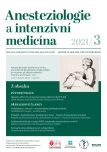Central anticholinergic syndrome – forgotten diagnosis
Authors:
J. Vagner 1; J. Votava 1; A. Spálený 1
Authors place of work:
Klinika anesteziologie, resuscitace a intenzivní medicíny 1. lékařská fakulta Univerzity Karlovy a Ústřední vojenská, nemocnice Praha
Published in the journal:
Anest. intenziv. Med., 32, 2021, č. 3, s. 164-167
Category:
Kazuistika
Summary
Our article presents a case report of patient with persistent impaired consciousness on awakening from general anesthesia. A 65-year-old patient with Crohn’s disease was indicated for scheduled laparoscopic assisted ileocecal resection. The operation was performed without complications under general anesthesia. In the immediate post-anesthetic period, a quantitative disorder of consciousness of the nature of significant somnolence to sopor dominated. The state of consciousness did not improve over time and therefore naloxone and aminophyllin were administered to patients with a suspected prolonged opiate effects. However, their administration did not lead to an adjustment of the consciousness. After excluding all other causes of disturbances of consciousness, we considered central anticholinergic syndrome (CAS) and proceeded to the administration of physostigmine. Patients regained full alertness, accelerated psychomotor pace, and improved muscle strength within a minute. Further course of hospitalization without any sights.
Keywords:
prolonged recovery from anesthesia – physostigmine – anticholinergic syndrome
Zdroje
1. Misal US, Joshi SA, Shaikh MM. Delayed recovery from anesthesia: A postgraduate educational review. Anesth Essays Res. 2016 May‑Aug; 10(2): 164–172.
2. Hess L, Málek J, Schreiberová J. Fyzostigmin a jeho použití v současné anesteziologii a intenzivní medicíně. Anest. Intenziv.Med. 2006; 17(6): 287–294.
3. Rupreht J, Dworacek B. Centrální anticholinergní syndrom (CAS) v pooperačním období. Anesteziologie a neodkladná péče. 1999; 10(3): 94–100.
4. Mark Su, MD, MPH. Matthew Goldman, MD. Anticholinergic poisonong. UpToDate. 2020 [cit. 2020-03-24]. Dostupné z: https://www.uptodate.com/contents/anticholinergic‑poisoning.
5. Rasimas JJ, Sachdeva KK, Donovan JW. Revival of an antidote: bedside experience with physostigmine. Toxicology Communications. 2018; 2(1): 85–101. doi: 10.1080/24734306.2018.1535538
6. Cao X, Cui Y, White PF, Tang J, Ma H. Central anticholinergic syndrome vs. idiosyncratic reaction triggered by a small IV dose of atropine. Acta Anaesthesiol Scand. 2016; 60(2): 270–273.
7. Cook B, Spence AA. Post‑operative central anticholinergic syndrome. Eur J Anaesthesiol. 1997 Jan; 14(1): 1–2.
8. Piper SN. Do patients profit from physostigmine in recovery from desflurane anaesthesia? Acta Anaesthesiol Scand. 2007; 51(3): 278–283.
9. Cho H, Kim J. Development of postoperative central anticholinergic syndrome due to low‑dose intravenous fentanyl. Saudi J Anaesth. 2018; 12(2): 328–331.
10. Moos DD. Central anticholinergic syndrome: a case report. J Perianesth Nurs. 2007 Oct; 22(5): 309–321. doi: 10.1016/j.jopan.2007. 05. 006.
Štítky
Anesteziologie a resuscitace Intenzivní medicínaČlánek vyšel v časopise
Anesteziologie a intenzivní medicína

2021 Číslo 3
- Perorální antivirotika jako vysoce efektivní nástroj prevence hospitalizací kvůli COVID-19 − otázky a odpovědi pro praxi
- Neodolpasse je bezpečný přípravek v krátkodobé léčbě bolesti
- Jak souvisí postcovidový syndrom s poškozením mozku?
- Měli bychom postcovidový syndrom léčit antidepresivy?
- Účinnost kombinace diklofenak/orfenadrin v terapii poruch pohybového aparátu
Nejčtenější v tomto čísle
- Centrální anticholinergní syndrom – zapomenutá diagnóza
- Propofol v Československu používáme již 30 let – historie intravenózních anestetik
- Systémové kortikoidy v terapii ARDS vyvolaného onemocněním covid-19
- Kompartmenty a blokády nervů v oblasti bérce

